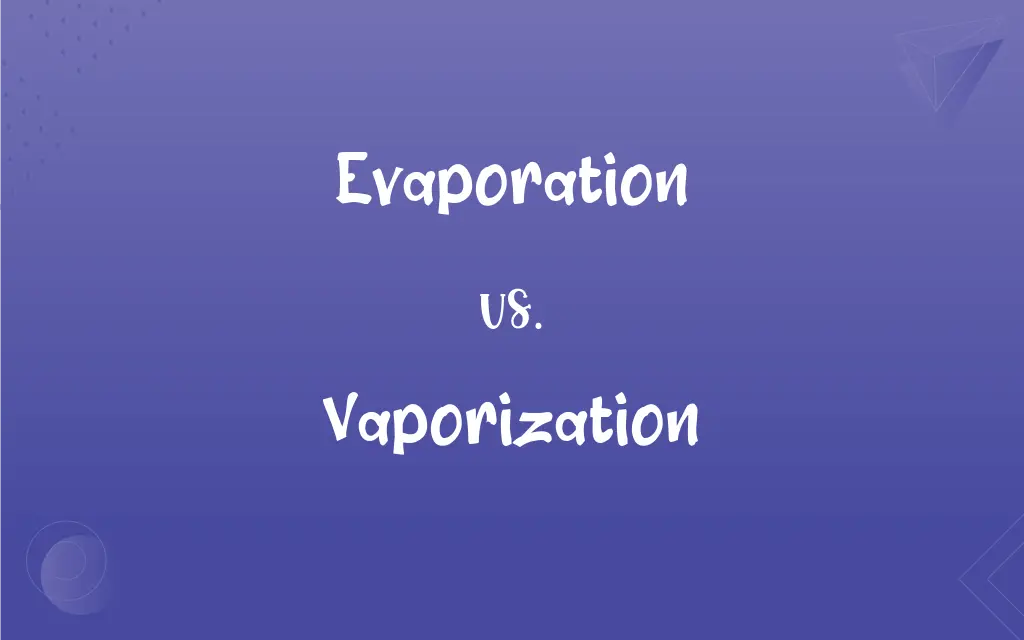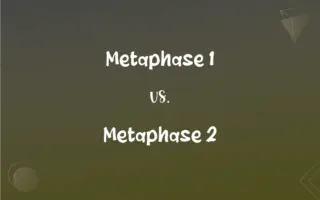Evaporation vs. Vaporization: What's the Difference?
Edited by Aimie Carlson || By Harlon Moss || Updated on October 10, 2023
Evaporation is surface-level phase transition from liquid to gas at temperatures below boiling point, while vaporization encompasses both evaporation and boiling, occurring at any temperature.

Key Differences
Evaporation refers to the process wherein particles from a liquid phase become vapor while generally only occurring at the surface of the liquid. On the other hand, vaporization is a term utilized to describe a phase transition from a liquid to a gas and may occur in any part of the liquid, not solely at its surface. Evaporation is typically a slower, more selective process, where only molecules with sufficient energy to overcome atmospheric pressure can escape into the gaseous phase. In contrast, vaporization implies a more encompassing process which may involve heating the liquid to its boiling point, therefore involving more molecular participation throughout the liquid.
In the context of ambient or room temperature situations, evaporation is a commonplace phenomenon that doesn’t require an external heat source. Vaporization, conversely, could be either spontaneous like evaporation or induced by heating. The processes might seem similar, yet their underlying mechanisms establish their distinct nature. The rate of evaporation can be influenced by factors like surface area, temperature, and humidity, whereas the rate of vaporization is mainly influenced by the temperature in relation to the boiling point of the liquid.
The humidity and air flow are vital factors that influence evaporation. Vaporization, in its comprehensive sense, also includes evaporation but doesn’t assign significant weightage to factors like air flow or humidity when boiling is concerned. It’s pivotal to note that evaporation is customarily a cooling process due to the loss of high-energy molecules, which leads to a reduction in the average kinetic energy of the remaining molecules. Vaporization through boiling, on the contrary, demands continuous heating to sustain the phase transition.
Evaporation holds prominence in natural phenomena such as the water cycle, contributing to rainfall and climate patterns. Vaporization, especially when boiling is concerned, is widely utilized in industrial and culinary applications for changing the state of liquids. Subtle yet pivotal, the distinction between evaporation and vaporization becomes apparent when considering these processes in diverse scientific, industrial, and everyday contexts, each embodying their unique implications and operational prerequisites.
Understanding that evaporation is a subset of vaporization allows us to acknowledge that while all evaporation is vaporization, not all vaporization is evaporation. Thus, the application and consideration of these processes are contextually bound, ensuring that the accurate term is utilized in scientific and casual communication to convey the particular physical transformation being described, either being a gentle transition (evaporation) or a more energetically inclusive one (vaporization).
ADVERTISEMENT
Comparison Chart
Definition
Phase change at below boiling point
Phase change at any temperature
Occurrence
Only at the surface of the liquid
Throughout the liquid
Temperature Dependency
Occurs below boiling point
Can occur at and above boiling point
Energy Requirement
Generally lower
Can be high (in case of boiling)
Influencing Factors
Surface area, air flow, and humidity
Primarily temperature (also pressure)
ADVERTISEMENT
Evaporation and Vaporization Definitions
Evaporation
Evaporation can occur in all types of climates and doesn’t require added heat.
Despite the chilly breeze, evaporation slowly diminished the dew on the grass.
Vaporization
Vaporization refers to the phase transition from a liquid state to a gaseous state.
Heating water in a kettle leads to its vaporization into steam.
Evaporation
Evaporation is the surface-level transition of a liquid into a gas below its boiling point.
The puddle gradually disappeared through evaporation under the warm sun.
Vaporization
Vaporization includes boiling, where liquid turns to gas throughout, not just at the surface.
Upon heating, the vaporization of water in the pot was evident by bubbling and steam.
Evaporation
Evaporation is a cooling process, where the most energetic molecules escape, reducing the average energy of remaining molecules.
Evaporation of sweat from your skin cools you down on a hot day.
Vaporization
Vaporization can occur at any temperature, depending on the substance and ambient pressure.
The vaporization of dry ice into carbon dioxide gas happens even in a freezer.
Evaporation
Evaporation is influenced by factors like temperature, surface area, and air flow.
The larger surface area of the spilled juice accelerated its evaporation.
Vaporization
Vaporization can occur either through boiling or evaporation.
The vaporization of alcohol occurs readily, even at room temperature.
Evaporation
Evaporation plays a crucial role in natural phenomena like the water cycle.
Evaporation from the oceans significantly contributes to the global water cycle.
Vaporization
Vaporization often necessitates energy input, especially in the context of boiling.
The vaporization of liquid nitrogen requires a substantial amount of heat due to its low boiling point.
Evaporation
To convert or change into a vapor.
Vaporization
To convert or be converted into vapor.
Evaporation
To draw off in the form of vapor.
Vaporization
A conversion of a solid or a liquid into a gas.
Vaporization
A destruction of something by turning it into vapor.
Vaporization
The act or process of vaporizing, or the state of being converted into vapor; the artificial formation of vapor; specifically, the conversion of water into steam, as in a steam boiler.
Vaporization
Annihilation by vaporizing something
Vaporization
The process of becoming a vapor
FAQs
What does vaporization mean?
Vaporization refers to the transformation of a liquid into a gas, either through boiling or evaporation.
What’s a real-life example of evaporation?
The drying of wet clothes is a common example of evaporation.
Can evaporation happen at any temperature?
Yes, evaporation can happen at any temperature, but it's more prominent in higher temperatures.
Does vaporization always require external heating?
No, vaporization can occur without external heating, especially in the case of evaporation.
Can vaporization occur in solids?
Typically no, but sublimation is a similar process where solids change directly to gas without a liquid phase.
How is vaporization utilized in industries?
Vaporization is used in processes like distillation in chemical industries to separate substances based on their boiling points.
How does evaporation occur naturally?
Evaporation happens naturally when molecules at the liquid surface gain enough energy to transform into gas.
How is evaporation different from boiling?
Evaporation occurs only at the surface of a liquid, whereas boiling occurs throughout.
Does vaporization result in a change of chemical composition?
No, vaporization alters the physical state of a substance but not its chemical composition.
Is boiling a form of vaporization?
Yes, boiling is a form of vaporization that occurs throughout the liquid.
What factors influence vaporization?
Factors influencing vaporization include temperature, pressure, and the substance's properties.
Why does evaporation cause cooling?
Evaporation causes cooling as high-energy molecules escape, leaving lower-energy, cooler molecules behind.
Is vaporization an endothermic process?
Yes, vaporization is generally endothermic as it requires energy to change the phase of a substance.
Can evaporation occur in a closed system?
Yes, evaporation can occur in a closed system until equilibrium is reached between the liquid and vapor phases.
How is the rate of evaporation measured?
The rate of evaporation can be measured as the amount of substance evaporated per unit of time.
What role does evaporation play in the water cycle?
Evaporation contributes to cloud formation and ultimately precipitation in the water cycle.
How does surface area affect evaporation?
A larger surface area generally enables faster evaporation due to more molecules being exposed to the atmosphere.
What is evaporation?
Evaporation is the process of liquid turning into vapor at the surface, below its boiling point.
Is it possible to prevent vaporization?
Completely preventing vaporization is challenging but reducing heat and increasing pressure can minimize it.
Does pressure impact vaporization?
Yes, reducing pressure generally lowers the temperature needed for vaporization.
About Author
Written by
Harlon MossHarlon is a seasoned quality moderator and accomplished content writer for Difference Wiki. An alumnus of the prestigious University of California, he earned his degree in Computer Science. Leveraging his academic background, Harlon brings a meticulous and informed perspective to his work, ensuring content accuracy and excellence.
Edited by
Aimie CarlsonAimie Carlson, holding a master's degree in English literature, is a fervent English language enthusiast. She lends her writing talents to Difference Wiki, a prominent website that specializes in comparisons, offering readers insightful analyses that both captivate and inform.































































